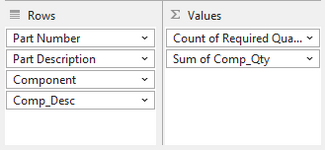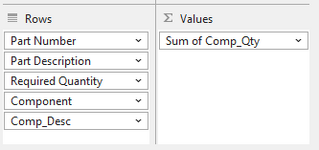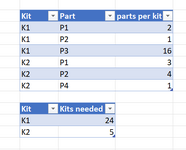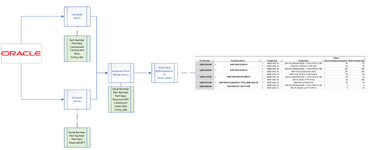Hi,
I have a pivot table with two value columns. The data changes each day. One of the columns tells the user the total number (count of Required Quantity) of hardware packs that are required. The second column sums the total parts within the hardware packs (Sum of Comp_Qty). I am trying to create a single line of the hardware pack number and leave the component level as is.
The data is currently correct for both the quantity of hardware packs to make and the total number of components in all the hardware packs. This information is used by our warehouse to pick the total components and create the total count of the hardware packs.
Here is the current configuration that is incorrect.


I need it to show SHIP HDW UNTZ FLATBR KIT = 24 and the Sum of Comp_Qty to stay the same.
Here is an example of what I need.

When I try and move the Required Quantity field to the left of Component, it changes the value from 24 (correct) to 1 (incorrect).


Does anyone know how I can make my Pivot Table show the values in the format I need?
Thank you for the help!
Mike
I have a pivot table with two value columns. The data changes each day. One of the columns tells the user the total number (count of Required Quantity) of hardware packs that are required. The second column sums the total parts within the hardware packs (Sum of Comp_Qty). I am trying to create a single line of the hardware pack number and leave the component level as is.
The data is currently correct for both the quantity of hardware packs to make and the total number of components in all the hardware packs. This information is used by our warehouse to pick the total components and create the total count of the hardware packs.
Here is the current configuration that is incorrect.


I need it to show SHIP HDW UNTZ FLATBR KIT = 24 and the Sum of Comp_Qty to stay the same.
Here is an example of what I need.

When I try and move the Required Quantity field to the left of Component, it changes the value from 24 (correct) to 1 (incorrect).


Does anyone know how I can make my Pivot Table show the values in the format I need?
Thank you for the help!
Mike










